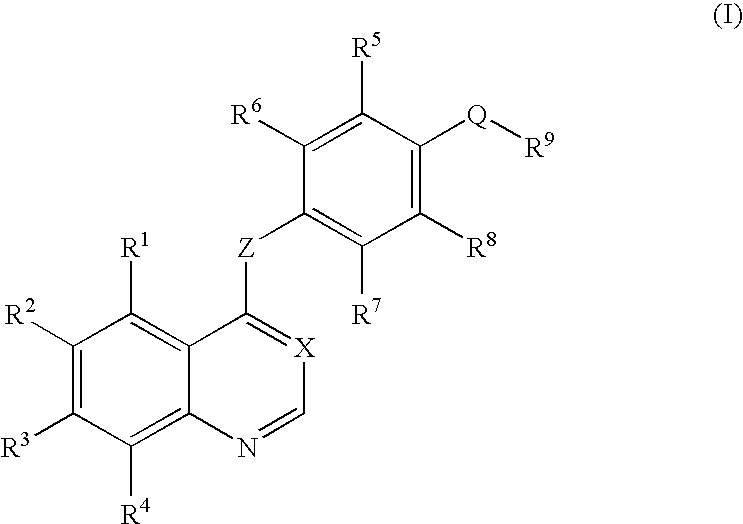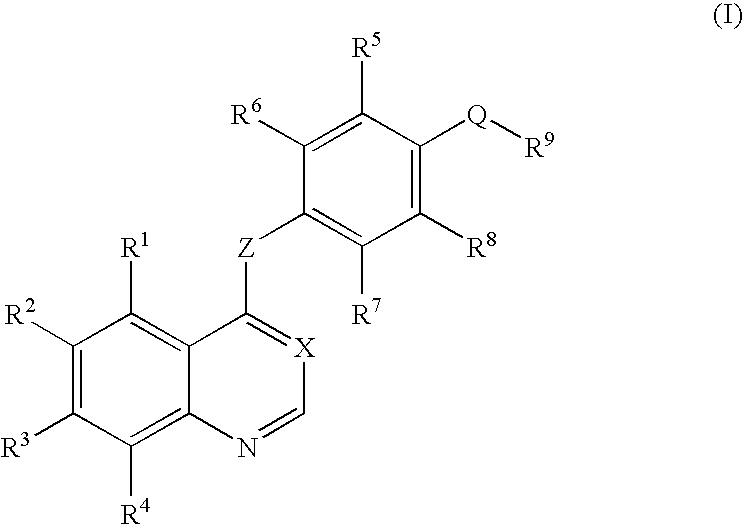Quinoline or quinazoline derivatives inhibiting auto-phosphorylation of fibroblast growth factor receptors
a technology of fibroblast growth factor receptor and quinoline, which is applied in the direction of biocide, animal repellents, drug compositions, etc., can solve the problem of not reporting on compounds capable of inhibiting autophosphorylation, and achieve the effect of suppressing the growth of cancer cells and potent anti-tumor activity
- Summary
- Abstract
- Description
- Claims
- Application Information
AI Technical Summary
Benefits of technology
Problems solved by technology
Method used
Image
Examples
preparation example 1 (
Starting Compound 1)
[0163]4-Aminophenol (12.21 g) and sodium methoxide (28% methanol solution, 21.07 g) were dissolved in N,N-dimethylacetamide (140 ml) to prepare a solution which was then stirred at room temperature for one hr. The solvent was removed by evaporation under the reduced pressure. 7-(Benzyloxy)-4-chloro-6-methoxyquinoline (21.00 g) and N,N-dimethylacetamide (210 ml) were added to the residue, and the mixture was stirred at 120° C. for 22 hr. The solvent was removed by evaporation under the reduced pressure. Water (300 ml) was added to the residue, and the mixture was stirred at room temperature for 4 hr. The resultant precipitate was collected by filtration and was dried to give the target compound (24.90 g, yield 96%).
preparation example 2 (
Starting Compound 2)
[0164]4-{[7-(Benzyloxy)-6-methoxy-4-quinolyl]oxy}aniline (18.60 g), 4-tert-butylphenylboronic acid (17.8 g), copper(II) acetate (22.7 g), and triethylamine (50 ml) were added to chloroform, and the mixture was stirred at room temperature for 96 hr. Water was added to the reaction solution, and the mixture was extracted with chloroform. The chloroform layer was dried over sodium sulfate. The solvent was removed by evaporation under the reduced pressure. The crude was purified by chromatography on silica gel using chloroform / acetone for development to give the target compound (7.89 g, yield 31%).
preparation example 3 (
Starting Compound 3)
[0165]7-(Benzyloxy)-4-chloro-6-methoxyquinoline (9.00 g) and 3-fluoro-4-nitrophenol (5.66 g) were added to chlorobenzene (60 ml), and the mixture was stirred at 120° C. for 21 hr. Chloroform (100 ml) and an aqueous sodium hydroxide solution (prepared by dissolving sodium hydroxide (2.4 g) in water (100 ml)) were added to the reaction solution, and the mixture was stirred at room temperature overnight. The organic layer was extracted with chloroform, and the chloroform layer was washed with an aqueous saturated sodium hydrogencarbonate solution and saturated brine. The chloroform layer was dried over sodium sulfate. The solvent was removed by evaporation under the reduced pressure. The crude thus obtained was washed with hexane / ethyl acetate (1 / 1), then the target compound was collected by filtration, dried and given (10.39 g, yield 82%).
PUM
| Property | Measurement | Unit |
|---|---|---|
| pH | aaaaa | aaaaa |
| volume | aaaaa | aaaaa |
| pharmaceutical composition | aaaaa | aaaaa |
Abstract
Description
Claims
Application Information
 Login to View More
Login to View More - R&D
- Intellectual Property
- Life Sciences
- Materials
- Tech Scout
- Unparalleled Data Quality
- Higher Quality Content
- 60% Fewer Hallucinations
Browse by: Latest US Patents, China's latest patents, Technical Efficacy Thesaurus, Application Domain, Technology Topic, Popular Technical Reports.
© 2025 PatSnap. All rights reserved.Legal|Privacy policy|Modern Slavery Act Transparency Statement|Sitemap|About US| Contact US: help@patsnap.com



